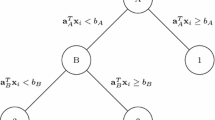Abstract
This paper presents the encoding of binary arithmetic operations within Integer Programming (IP) formulations, specifically the encoding of binary multiplication and addition/subtraction. This allows the direct manipulation of integer quantities represented as binary strings of arbitrary size. Many articles published in the past within the Chemical Engineering community have used this representation of integer quantities within Mixed-Integer formulations for Process Optimization and Design. Applications such as these can benefit from the formulations derived in this work. As a demonstrative application we consider the simple number factorization problem, according to which given an odd number C factors A and B are to be found such that C equals their product. If any such factors are found the number is factorable, else it is proven to be prime. An IP formulation is derived involving upper and lower bounding logical constraints to encode for the value of the binary string digits. The formulation involves \({\cal O}(\log C)\) binary variables, \({\cal O}((\log C)^{2})\) continuous variables, and \({\cal O}((\log C)^{2})\) constraints to describe the problem. Computational results demonstrate the validity of this approach, highlighting also the fact that such formulations are not very tight thus resulting in large numbers of iterations of the Branch and Bound algorithm used. It is also observed that the formulations become significantly tighter if logical upper bounding constraints forcing continuous variables involved to be zero are included.
Similar content being viewed by others
References
Adams, W.P., Henry, S.M.: Base-2 expansions for linearizing products of functions of discrete variables. Oper. Res. 60(6), 1477–1490 (2012)
Agrawal, M., Kayal, N., Saxena, N.: Primes is in p. Ann. Math. 2, 781–793 (2002)
Bienstock, D., Chopra, S., Günlük, O., Tsai, C.Y.: Minimum cost capacity installation for multicommodity network flows. Math. Program. 81, 177–199 (1998)
Brooke, A., Kendrick, D., Meeraus, A.: GAMS: A User’s Guide. Scientific Press, Palo Alto, CA (1988)
CPLEX: Using the CPLEX Callable Library. ILOG Inc., CPLEX Division, 930 Tahoe Blvd. #802-279, Incline Village, NV 89451-9436, USA (1997)
Dandamudi, S.P.: Fundamentals of Computer Organization and Design. Springer (2003)
Dietzfelbinger, M.: Primality Testing in Polynomial Time. Springer (2004)
Floudas, C.: Nonlinear and Mixed-Integer Optimization. Oxford University Press, 198, Madison Avenue, New York, New York 10016, USA (1995)
Grossmann, I.E.: Review of nonlinear mixed-integer and disjunctive programming techniques. Optim. Eng. 3, 227–252 (2002)
Grossmann, I.E., Caballero, J.A., Yeomans, H.: Mathematical programming approaches to the synthesis of chemical process systems. Korean J. Chem. Eng. 16, 407–426 (1999)
Harjunkoski, I., Grossmann, I.E.: Decomposition techniques for multistage scheduling problems using mixed-integer and constraint programming methods. Comput. Chem. Eng. 26(11), 1533–1552 (2002)
Laporte, G., Nobert, Y.: A branch and bound algorithm for the capacitated vehicle routing problem. Oper. Res. Spectrum. 5, 77–85 (1983)
Manin, Y.I., Panchishkin, A.A.: Introduction to Modern Number Theory. Springer (2007)
Méndez, C.A., Cerdá, J., Grossmann, I.E., Harjunkoski, I., Fahl, M.: State-of-the-art review of optimization methods for short-term scheduling of batch processes. Comput. Chem. Eng. 30(6–7), 913–946 (2006)
Muldoon, F.M., Adams, W.P., Sherali, H.D.: Ideal representations of lexicographic orderings and base-2 expansions of integer variables. Oper. Res. Lett. 41(1), 32–39 (2013)
Pochet, Y., Wolsey, L.: Production Planning by Mixed Integer Programming (Springer Series in Operations Research and Financial Engineering). Springer-Verlag New York, Inc., Secaucus, NJ, USA (2006)
Ralphs, T.K., Kopman, L., Pulleyblank, W.R., Trotter, L.E.: On the capacitated vehicle routing problem. Math. Program. 94, 343–359 (2003)
You, F., Grossmann, I.E.: Mixed-integer nonlinear programming models and algorithms for large-scale supply chain design with stochastic inventory management. Ind. Eng. Chem. Res. 47(20), 7802–7817 (2008)
Author information
Authors and Affiliations
Corresponding author
Rights and permissions
About this article
Cite this article
Conejeros, R., Vassiliadis, V.S. & Pogiatzis, T.A. Encoding Binary Arithmetic Operations in Integer Programming Formulations. J Math Model Algor 13, 143–167 (2014). https://doi.org/10.1007/s10852-013-9225-9
Received:
Accepted:
Published:
Issue Date:
DOI: https://doi.org/10.1007/s10852-013-9225-9




